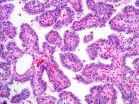Dartmouth study measures breast cancer tumor response to neoadjuvant chemotherapy
DOST imaging could be used to predict tumor response before starting treatment
2014-10-23
(Press-News.org) A Dartmouth study suggests that it may be possible to use Diffuse Optical Spectroscopic Tomographic imaging (DOST) to predict which patients will best respond to chemotherapy used to shrink breast cancer tumors before surgery. These findings could eliminate delays in effective early treatment for tumors unlikely to respond to neoadjuvant chemotherapy (NAC). The study, "Predicting breast tumor response to neoadjuvant chemotherapy with Diffuse Optical Spectroscopic Tomography prior to treatment," was published online in Clinical Cancer Research on October 7, 2014.
Breast cancer is the most common non-skin cancer in women worldwide, and the second leading cause of women's cancer mortality in the United States. A common treatment strategy after diagnosis is to shrink breast cancer tumors larger than 3 centimeters with a 6- to 8-month course of NAC prior to surgery. Clinical studies have shown that patients who respond to NAC have longer disease-free survival rates, but only 20 to 30 percent of patients who receive NAC fit this profile.
"Our work represents the first clinical evidence that tumor total hemoglobin (estimated from DOST images) is different in the women with locally advanced breast cancer who respond to neoadjuvant chemotherapy," said lead author Shidong Jiang, associate professor of Engineering at the Thayer School of Engineering at Dartmouth. "We were able to predict breast tumor response to NAC based on image data acquired before the initiation of therapy."
DOST imaging is used to measure tumor tissue for hemoglobin and oxygen saturation levels—key indicators of the presence the tiny blood vessels cancer tumors need to grow. This study suggests that biomarkers obtained through DOST imaging could help physicians determine the best treatment strategy for patients.
"The implication of this information is that certain tumors are pre-disposed to responding to neoadjuvant chemotherapy, and that this predisposition could be known prior to choosing the therapy," says Jiang. "The study also could dramatically accelerate future randomized clinical trials on optimal NAC regimes. By using a validated imaging surrogate as an outcome measure, we could potentially reduce the number of patients required, and the length of time they need to be followed."
Jiang says the next step will be to develop a portable and compact system to more accurately measure changes in the breast prior or/and during neoadjuvant chemotherapy. This system could be integrated into the workflow of clinical oncology practice to maximize patient participation, and determine whether additional prognostic information could be obtained that would influence patient management.
INFORMATION:
This research is supported by National Cancer Institute research grants PO1 CA80139, R01 CA069544, and R01CA176086.
About Norris Cotton Cancer Center at Dartmouth-Hitchcock
Norris Cotton Cancer Center combines advanced cancer research at Dartmouth and the Geisel School of Medicine with patient-centered cancer care provided at Dartmouth-Hitchcock Medical Center, at Dartmouth-Hitchcock regional locations in Manchester, Nashua, and Keene, NH, and St. Johnsbury, VT, and at 12 partner hospitals throughout New Hampshire and Vermont. It is one of 41 centers nationwide to earn the National Cancer Institute's "Comprehensive Cancer Center" designation. Learn more about Norris Cotton Cancer Center research, programs, and clinical trials online at cancer.dartmouth.edu.
ELSE PRESS RELEASES FROM THIS DATE:
2014-10-23
BOSTON - New achievements in synthetic biology announced today by researchers at the Wyss Institute for Biologically Inspired Engineering, which will allow complex cellular recognition reactions to proceed outside of living cells, will dare scientists to dream big: there could one day be inexpensive, shippable and accurate test kits that use saliva or a drop of blood to identify specific disease or infection — a feat that could be accomplished anywhere in the world, within minutes and without laboratory support, just by using a pocket–sized paper diagnostic ...
2014-10-23
(Santa Barbara, Calif.) — Volatile rainstorms drive complex landscape changes in deserts, particularly in dryland channels, which are shaped by flash flooding. Paradoxically, such desert streams have surprisingly simple topography with smooth, straight and symmetrical form that until now has defied explanation.
That paradox has been resolved in newly published research conducted by Michael Singer and Katerina Michaelides, associate researchers at UC Santa Barbara's Earth Research Institute. The pair show that simple topography in dryland channels is maintained ...
2014-10-23
DALLAS – Oct. 23, 2014 – A hormone seen as a popular target to develop weight-loss drugs works by directly targeting the brain and triggering previously unknown activity in the nervous system, UT Southwestern Medical Center obesity researchers have found.
The fibroblast growth factor 21 (FGF21) hormone has been a key target for developing weight-loss drugs because the protein increases energy expenditure, causing the body to burn calories. But how the hormone worked wasn't known until now.
UT Southwestern researchers tracking the hormone discovered that ...
2014-10-23
DENVER – Sixteen institutions across Europe collaborated together to show for the first time that a semi-quantitative anaplastic lymphoma kinase (ALK) protein expression test, immunohistochemistry (IHC), is reliable amongst several laboratories and reviewers when test methodology and result interpretation are strictly standardized and the scoring pathologists are appropriately trained on the test.
ALK tyrosine kinase inhibitors (TKIs) shrink tumors and increase progression-free survival in late-stage non-small cell lung cancer (NSCLC) patients positive for ALK as ...
2014-10-23
DENVER –CANARY, Computer-Aided Nodule Assessment and Risk Yield, is a novel software tool developed at Mayo Clinic that can automatically quantitate adenocarcinoma pulmonary nodule characteristics from non-invasive high resolution computed tomography (HRCT) images and stratify non-small cell lung cancer (NSCLC) patients into risk groups that have significantly different disease-free survival outcomes.
The majority of NSCLC patients are diagnosed with advanced-stage disease which is concomitant with an exceptionally poor prognosis, 5-year survival rate of 4%. In ...
2014-10-23
In individuals living in the Arctic, researchers have discovered a genetic variant that arose thousands of years ago and most likely provided an evolutionary advantage for processing high-fat diets or for surviving in a cold environment; however, the variant also seems to increase the risk of hypoglycemia, or low blood sugar, and infant mortality in today's northern populations. The findings, published online October 23 in Cell Press's American Journal of Human Genetics, provide an example of how an initially beneficial genetic change could be detrimental to future generations. ...
2014-10-23
People may have been making their way from Easter Island to the Americas well before the Dutch commander Jakob Roggeveen arrived with his ships in 1722, according to new genomic evidence showing that the Rapanui people living on that most isolated of islands had significant contact with Native American populations hundreds of years earlier. The findings reported in the Cell Press journal Current Biology on October 23 lend the first genetic support for such an early trans-Pacific route between Polynesia and the Americas, an impressive trek of more than 4,000 kilometers (nearly ...
2014-10-23
Synthetic gene networks hold great potential for broad biotechnology and medical applications, but so far they have been limited to the lab. A study published by Cell Press October 23rd in the journal Cell reveals a new method for using engineered gene circuits beyond the lab, allowing researchers to safely activate the cell-free, paper-based system by simply adding water. The low-cost, easy-to-use platform could enable the rapid detection of different strains of deadly viruses such as Ebola.
"Our paper-based system could not only make tools currently only available ...
2014-10-23
ANN ARBOR, Mich. — A new comprehensive analysis of thyroid cancer from The Cancer Genome Atlas Research Network has identified markers of aggressive tumors, which could allow for better targeting of appropriate treatments to individual patients.
The finding suggests the potential to reclassify the disease based on genetic markers and moves thyroid cancer into a position to benefit more from precision medicine.
"This understanding of the genomic landscape of thyroid cancer will refine how it's classified and improve molecular diagnosis. This will help us separate ...
2014-10-23
LA JOLLA, CA – October 23, 2014 - Scientists at The Scripps Research Institute (TSRI) have discovered a way to decrease deadly protein deposits in the heart, kidney and other organs associated with a group of human diseases called the systemic amyloid diseases.
"If we can develop a strategy to reduce the load that's coming from these proteins, then we can open up treatment options that could be broadly applied to treat multiple systemic amyloid diseases," said Luke Wiseman, assistant professor at TSRI and a senior author of the new research.
In related studies ...
LAST 30 PRESS RELEASES:
[Press-News.org] Dartmouth study measures breast cancer tumor response to neoadjuvant chemotherapy
DOST imaging could be used to predict tumor response before starting treatment




